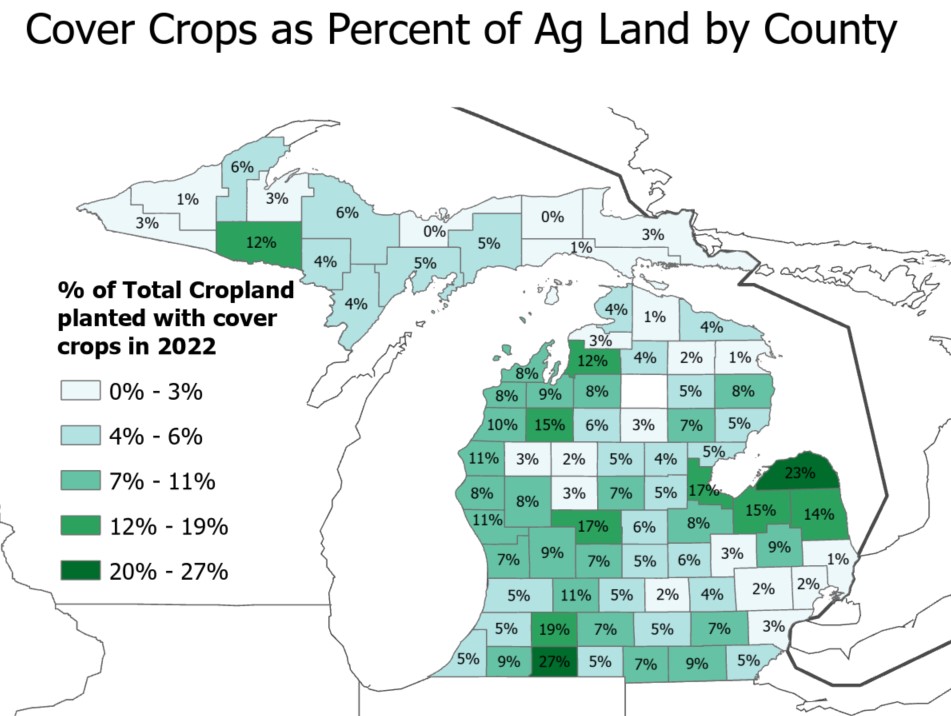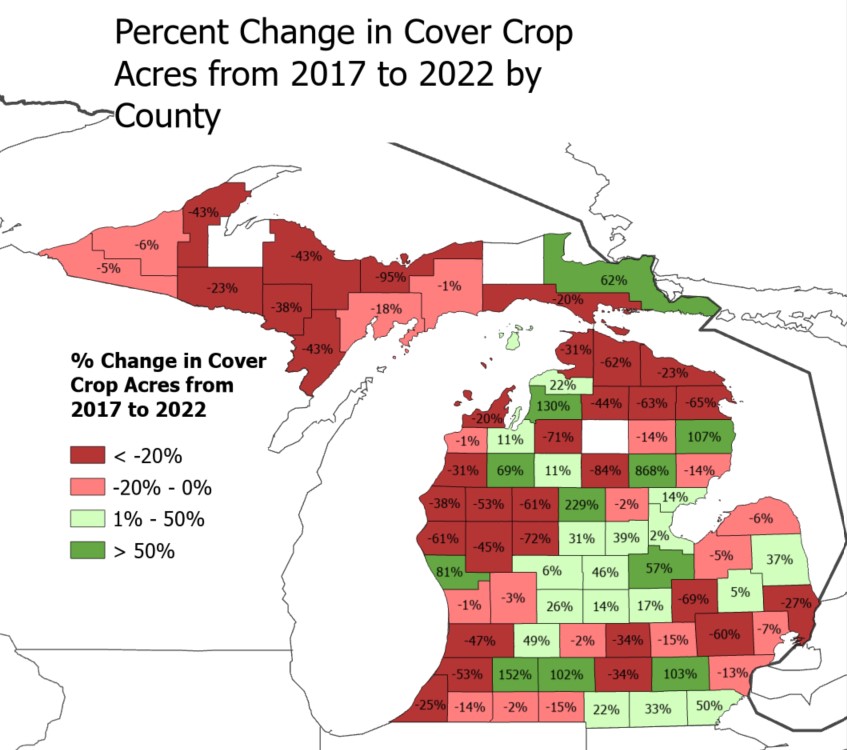Cover crop use in Michigan, reflecting on the 2022 Census of Agriculture
The 2022 Census of Agriculture results reveal latest trends in cover crop use in Michigan.

Every five years, the United States Department of Agriculture (USDA) Census of Agriculture provides a comprehensive glimpse into the state of agriculture in the United States. Practices like cover crop plantings are becoming more extensively discussed and supported across the U.S. and in Michigan, but adoption of cover crops vary widely.
When it comes to cover crop use nationally, there was a 17% increase (about 3 million acres increase) from 2017 to 2022, representing about 6% of all harvested cropland across the U.S. In Michigan, there was about a 2% increase in acres planted to cover crops from 2017 to 2022. Meaning that in 2022, 9% of harvested cropland in Michigan was planted into cover crops. While these numbers seem small on the macro scale, there is a larger story to be told.
Cover crop use increased over 50% nationally from 2012 to 2017, according to the last census cycle. So, does this less than 20% increase from 2017 to 2022 show that the momentum of cover crop adoption has slowed despite the growing attention and investment? Experts like Rob Myers, PhD, from the University of Missouri, point to multiple factors that may explain this trend in 2022:
- There was a decrease of nearly 20 million acres of harvested cropland from 2017 to 2022, meaning there were fewer acres to plant into cover crops.
- State by state, trends in crop use were not consistent. States that had a decrease or no change in cover crop acres may reflect the challenges of planting into dry weather conditions in 2022 and may have increases in winter wheat acres.
- Growth is rarely, if ever, a consistent upwards trend.
As multiple experts continue to point out, there is a world of nuance in agricultural management by region. In the case of cover crop use, Michigan is an incredible example of this due to the range of soils, weather conditions and crops.
Fourteen counties had over 10% of total cropland planted into cover crops in 2022, with Huron and St. Joseph counties having over 20% of total cropland acres planted into cover crops in 2022 (Figure 1). These regions of high acreage adoption in 2022 seem consistent with regions of high percentage of cover crop acreage adoption observed in 2017.

Among the 79 counties in Michigan for which data on cover crop use was available in both 2022 and 2017, 30 counties experienced an uptick in cover crop use while 49 counties observed a decline during the same period (Figure 2). Since ranges in the percent change of cover crop use in 2022 vary so drastically across the state, it can be difficult to say which factors directly influenced changes to cover crop adoption in Michigan, though some factors in cover crop use nationally (like changes in total cropland or weather challenges with planting) may be true for Michigan as well.

A major barrier to cover crop adoption is cost. Many times, the benefits of cover crops, especially the benefits to crop production and nutrient cycling, are not seen in the first years of implementation. Results from the 2022-2023 National Cover Crop Survey Report indicate the cost of cover crops remains a major barrier. According to the survey report, “Non-users reported an interest in reducing inputs by using cover crops (70% agreement) but were primarily deterred from adoption by concerns over economic return.”
Cost-share programs continue to play an important role in supporting farmers transitioning to cover crops. In the 2022-2023 National Cover Crop Survey Report, it was found that about 90% of respondents that received initial cover crop payments continued to use cover crops even after the payments ended. Opportunities for cost sharing on cover crops can be found by working with your local USDA service center and through a variety of organizations.
Cover crops have been shown to improve soil health, crop productivity and environmental stewardship. However, we also know the diversity of conditions in Michigan also brings a diversity of challenges with cover crops. Fortunately, several tools and management possibilities can help overcome these difficulties. Innovations in planting equipment can make it easier to plant in high residue situations. Advancements in the supply chain make a greater variety of seed for cover crop species more consistently available. Improved management strategies in cover crop termination are helping farmers get the most out of their cover crop without interfering with cash crop production. These innovations and more are making cover cropping work for each farm and farmer’s unique conditions.
To help navigate cover cropping choices or learn about your options, connect with:



 Print
Print Email
Email




